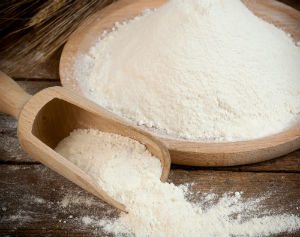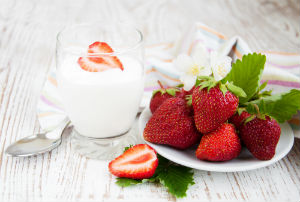Read This Before Adopting the Gluten-Free Diet
Published July 28, 2015 There's very little doubt you've encountered someone who's joined the gluten-free bandwagon, and perhaps you yourself have feverishly ditched this recently-maligned protein. Gluten has been seriously vilified by popular online bloggers, alternative health professionals, and celebrities, prompting a dietary movement that holds big promises but little serious scientific scrutiny. Of the research that is available on the dangers of gluten, we can clearly see that it isn't an essential component of the human diet, nor is it beneficial to gut, brain, or digestive health. [1] But did you know that there may be potential dangers of going gluten free?
What Is Gluten?
Gluten is a protein found in wheat, barley, and rye. [2] If you've ever baked your own bread, you have probably seen (and felt) the dough's sticky and elastic consistency. This is gluten. It provides the elasticity to help form and shape dough, and essentially provides a glue-like texture to keep it held together. Gluten has been in the food supply for thousands of years, ever since cultivation of wheat and wheat-like grains became a main facet to the human diet. So, it stands to reason that gluten (and grains, in general) haven't been consumed by humans for very long, if you consider the hundreds of thousands of years we've been around.
Gliadin is one of the components of gluten and represents a class of proteins found in various types of grains. It appears that it's the gliadin that imparts the specific health effects of gluten, especially for celiacs. [3] Glutenins represent the other half of gluten, but it's really the gliadin that we're going to focus on. Gliadin triggers an autoimmune response in celiacs, yet it may also be prompting an allergic response in people who are sensitive. Hidden symptoms of an allergic response to gliadin include skin irritation, watery eyes, depression, weight gain, and digestive upset.
One of the main issues we have with gluten is its difficulty with digestion. It's a hard, tough protein, and it's not exactly helpful for encouraging friendly bacteria in the intestines. If you've read this blog for awhile, you know that the friendly bacteria in your gut is responsible for regulating a healthy digestive and elimination system, and without them, bloating, gas, general digestive upset, thyroid suppression, and even weight gain can result. [4] Gluten also appears to promote swelling in the intestines, particularly for those with celiac disease and gluten intolerance. It turns out that even people with gluten sensitivity can experience issues with gluten, yet their symptoms are typically hidden.
The Dangers of Going Gluten Free
The gluten-free craze has its fair share of critics, evidenced by the many medical "experts" who chime in on the many gluten-free articles in magazines, newspapers, and online news mediums. Many nutrition experts or medical doctors who voice their concerns about the gluten-free diet do so from a backwards–but logical–mentality. Mainly, the concern is that by eliminating wheat–which is fortified with essential nutrients–and swapping it with non-fortified gluten-free starches and grains, the consumer places him or herself at risk for a nutrient deficiency.
Most processed foods that are heavily grain-based, like breads, pastas, crackers, cereals, and breakfast bars, use fortified wheat as the main ingredient. Fortified wheat includes added iron, B vitamins, and sometimes calcium. Critics of the gluten-free diet claim ditching the gluten and replacing it with gluten-free foods, adherents will place themselves at risk for a nutrient deficiency. [5] These claims fail to take into account that a gluten-free diet may translate into a healthier diet, especially if one commits to increasing natural whole foods, the majority of which are gluten free, like vegetables, nuts, and seeds.
Corn starch is one of the most prevalent wheat replacements used in gluten-free goods. Since corn is subsidized, it's relatively inexpensive and readily available. White flour, which is referred to as wheat flour interchangeably, has a soft, light texture that is matched well with starches, which is the main reason it's used heavily in the gluten-free industry. All gluten-free breads and baked goods will use starches like tapioca starch, potato starch, and arrowroot starch. Paleo baked goods, however, will tend to rely on lower carb, unrefined options, like coconut flour and almond flour. These are more nutrient dense; however, they are not commonplace in most products free from gluten.
Glycemic Load of the Gluten-Free Diet
The glycemic scale is a representative list of specific foods and their effects on blood sugar. Rating of the scale attributes specific numerical values from 0 to 100, with 0 representing no blood sugar response and 100 being the maximum blood sugar response (this is usually designated to refined sucrose). Low-glycemic foods are best for blood sugar management and are assigned to most vegetables, small berries, nuts, seeds, meats, and other low-carbohydrate foods. Those foods that rate medium on the glycemic index include many tropical, high-sugar fruits (banana, watermelon, mango, etc.), legumes, and grains. Starches are a bit higher than wheat on the glycemic index, regardless of whether the wheat is whole or refined.
Starches, like tapioca starch, corn starch, and potato starch, are devoid of fiber and have a more severe effect on blood sugar levels in the body compared to whole grains. Most gluten-free breads, pastas, and snacks rely on having a wheat-like consistency and texture, and starches provide a lightness that matches wheat much more so than gluten-free whole grains. These blend of starches in gluten-free products increase the refined carbohydrates and reduce the overall quality from a health standpoint. While some gluten-free products exclusively rely on whole grains, they are far more dense and heavy, and they don't provide a similar alternative to gluten-containing foods.
The Real Issue with the Gluten-Free Diet
The main issue really isn't with the starches, or even the gluten. What's really concerning is that many people are swapping out their processed foods with gluten-free alternatives. So, instead of purchasing conventional chocolate sandwich cookies, they replace them with nearly identical products that are made with gluten-free ingredients. Yes, the gluten is gone and that may provide some benefit; however, if the sugar and refined carbohydrates are still there (as they are with virtually any processed food), any benefit is being overridden by the blood sugar and insulin spike, as well as the internal swelling and irritation these ingredients cause in the body. [6] We simply can't blame gluten in the case of poor health, at least not entirely. This bread addiction, which many people face today, is the main driving force behind insulin resistance and weight gain.
The Best Gluten-Free Lifestyle Choices
One of the best ways to go gluten free is not to replace processed foods with gluten-free mimics, but to consume only fresh, whole foods. All whole foods that don't require cooking are naturally free from gluten. Think about vegetables, fruits, seaweed, nuts, seeds, and even meat (if you go that route). You can still eat grains, but pick the most nutritious varieties. Quinoa is a popular grain-like seed that doesn't contain gluten, and it's also high in all essential amino acids and fiber. Buckwheat, despite the suffix, is actually not related to the wheat plant at all and is a very nutritious gluten-free grain you should include in your diet. Be careful with oats, though, since many can be processed in a facility that also process wheat. Contamination is a serious and real threat to celiacs, so if oats should be eaten, always choose a brand that is certified as gluten free.
The Take Home
A gluten-free diet can be superior to a standard American diet, in both taste and nutrition. The key is using whole foods in your recipes and reducing the amount of grain carbohydrates you're consuming. While grains are by no means unhealthy, they are certainly not the most nutrient-dense foods on the planet. Look for alternative gluten-free grains like quinoa and buckwheat and include plenty of other naturally gluten-free foods like fruits, vegetables, nuts, and seeds.
-Dr. Edward F. Group III, DC, NP, DACBN, DCBCN, DABFM
References:
- Jessica R. Jackson, William W. Eaton, Nicola G. Cascella, Alessio Fasano, and Deanna L. Kelly. Neurologic and Psychiatric Manifestations of Celiac Disease and Gluten Sensitivity. Psychiatr Q. 2012 Mar; 83(1): 91-102. doi: 10.1007/s11126-011-9186-y.
- McGough N, Cummings JH. Coeliac disease: a diverse clinical syndrome caused by intolerance of wheat, barley and rye. Proc Nutr Soc. 2005 Nov;64(4):434-50.
- Howdle PD. Gliadin, glutenin or both? The search for the Holy Grail in coeliac disease. Eur J Gastroenterol Hepatol. 2006 Jul;18(7):703-6.
- Soares FL, de Oliveira Matoso R, Teixeira LG, et al. Gluten-free diet reduces adiposity, inflammation and insulin resistance associated with the induction of PPAR-alpha and PPAR-gamma expression. J Nutr Biochem. 2013 Jun;24(6):1105-11. doi: 10.1016/j.jnutbio.2012.08.009.
- Holly Strawbridge. Going gluten-free just because Here's what you need to know. Harvard Health Publications. Harvard Medical School.
- Juanola-Falgarona M, Salas-Salvado J, Ibarrola-Jurado N, et al. Effect of the glycemic index of the diet on weight loss, modulation of satiety, inflammation, and other metabolic risk factors: a randomized controlled trial. Am J Clin Nutr. 2014 Jul;100(1):27-35. doi: 10.3945/ajcn.113.081216.
The post Read This Before Adopting the Gluten-Free Diet appeared first on Dr. Group's Natural Health & Organic Living Blog.
More from Dr. Group's Blog:




